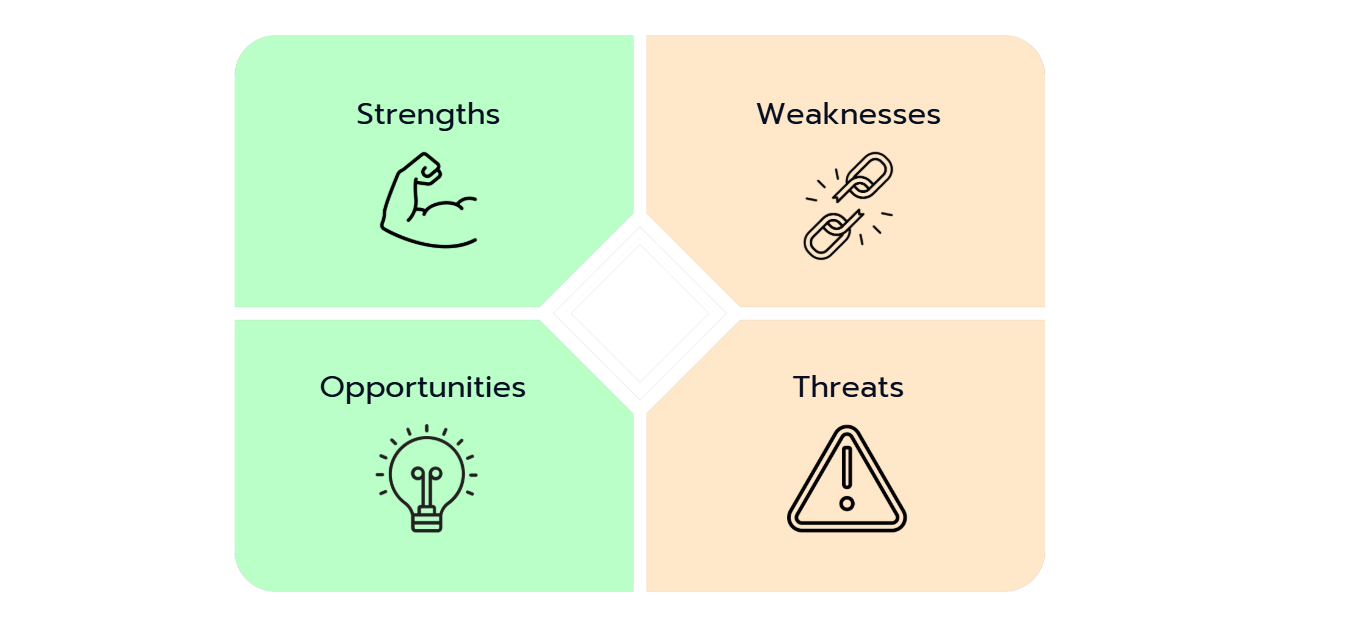In finance, strategic frameworks can make a real difference when it comes to understanding a company's position and long-term potential. Among them, the SWOT analysis stands out as a clear and practical method for assessing where a business stands and what factors could shape its future. Whether you're evaluating a target company, preparing for a case interview, or making investment decisions, mastering SWOT can give your analysis more depth and direction.
SWOT Analysis
What Is the SWOT Analysis?
SWOT is an acronym that stands for Strengths, Weaknesses, Opportunities, and Threats. Therefore, SWOT analysis is used to evaluate a company’s current situation by analyzing these four parameters.
Strengths and Weaknesses are internal, hence the company has control over them. However, Opportunities and Threats are external factors that businesses can only anticipate or respond to.
Using SWOT analysis in finance interviews can help to structure answers well, show your analytical capabilities, and demonstrate your ability to offer sound insights. All these are essential skills in finance roles.
Let’s explore the four parameters in detail:

Strengths
These are the internal resources or attributes that give a company an advantage over others. It’s what the company does well, the unique resources they have, or what sets them apart from competitors. Examples of general strengths include:
- Company-specific advantages like strong cash flows, low debt ratios, and proprietary technology
- Competitive advantages such as market share, brand equity, or efficient operations
- Management expertise, talent pool, and organizational capabilities
- Strong brand reputation
- Loyal customer base
- Long-term customer contracts
Weaknesses
The weaknesses part covers the internal but negative factors that place the organization at a disadvantage or hinder maximum performance. So, a weakness could be anything that needs improvement, for instance:
- Financial vulnerabilities such as high debt levels, poor liquidity, or margin pressure
- Operational inefficiencies or capacity constraints
- Areas where the company lags competitors like technology, talent, and scale
- Poor location
- High employee turnover
Opportunities
External factors can be positive or negative. Opportunities are on the positive side and represent factors a company can potentially exploit or leverage for growth and improvement. As external factors, the company can’t control them but can take advantage of them. Examples of general opportunities include:
- Favorable government policies or regulatory changes
- Market trends favorable to the business or investment
- Potential for expansion, acquisition, or new revenue streams
- Technological developments that could enhance operations or create new markets
Threats
Just like opportunities, threats are external factors that lie outside a company’s control. However, businesses can still prepare for them and take steps to reduce their potential impact. Threats typically refer to developments that could hinder a company’s objectives or pose a risk to its overall performance. Common examples include:
- Competitive pressures, including new entrants or substitute products
- New and unfavorable regulatory changes or compliance requirements
- Macroeconomic risks like recession, inflation, or interest rate changes
- Industry disruption or technology obsolescence
- Changing customer preferences
- Supply chain issues
How to Use SWOT in Finance Interviews
The SWOT analysis can help you structure your answers to complex investment questions in finance interviews—for example:
- "Is Apple a good investment?"
- "How do you assess Bank X’s planned acquisition of Fintech Y?"
- "What risks do you see in Company Z’s IPO?"
You can use SWOT either at the beginning to gain a strategic overview or at the end to complement your financial analysis and demonstrate sound judgment.
Here’s what a SWOT analysis of a potential investment in Apple might look like:
Example of integrating SWOT into your interview answer:
"Before I assess Apple as an investment, I would start by taking a strategic look.
On the positive side, we see an exceptionally strong brand, very stable free cash flows, and growth potential in the services segment.
On the other hand, the company’s dependence on the iPhone and increasing regulatory pressure should not be underestimated.
Combined with a financial analysis (e.g., valuation via DCF or multiples), this provides a fairly solid overall picture.
From a strategic perspective, Apple’s market position, balance sheet strength, and innovation pipeline continue to be compelling. I would therefore lean toward a positive investment recommendation."
Key Takeaways
SWOT analysis is a strategic planning technique used to identify and evaluate the Strengths, Weaknesses, Opportunities, and Threats relevant to a business, project, or situation. SWOT analysis is used to identify where an organization excels, where it can improve, what external possibilities can be leveraged, and what challenges need to be addressed.
Whether discussing investment opportunities, corporate strategies, or market conditions, SWOT provides a reliable structure that shows your analytical capabilities while ensuring you don't overlook crucial factors. Balance is important when using SWOT. Strong responses acknowledge both positives and negatives, showing intellectual honesty and comprehensive thinking.
Always quantify when possible. That is, strengthen your SWOT analysis by incorporating specific metrics, ratios, and market data. It’s good to adapt your SWOT emphasis based on the specific question such as valuation, strategy, market entry, or more.
